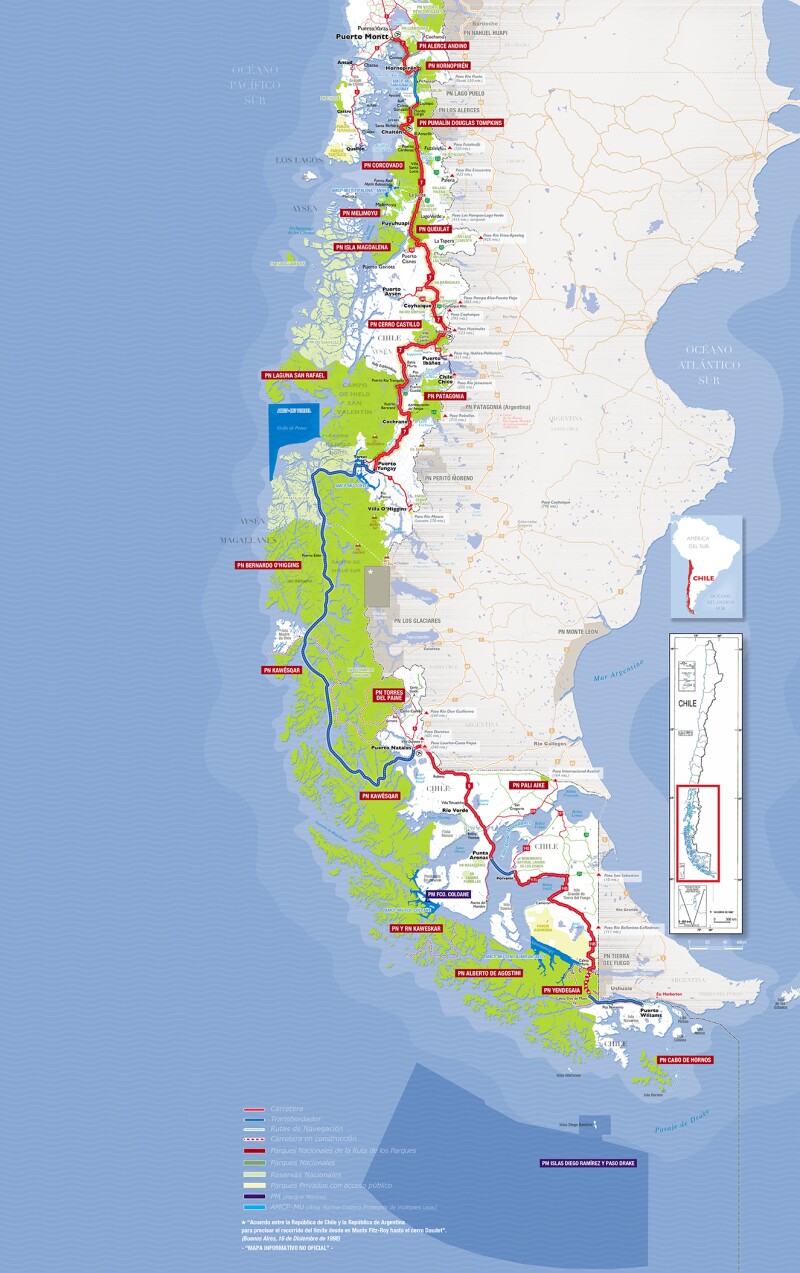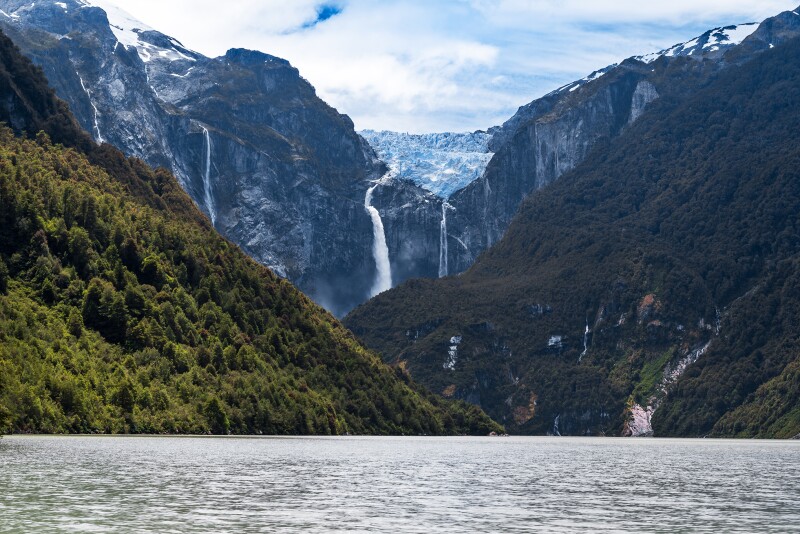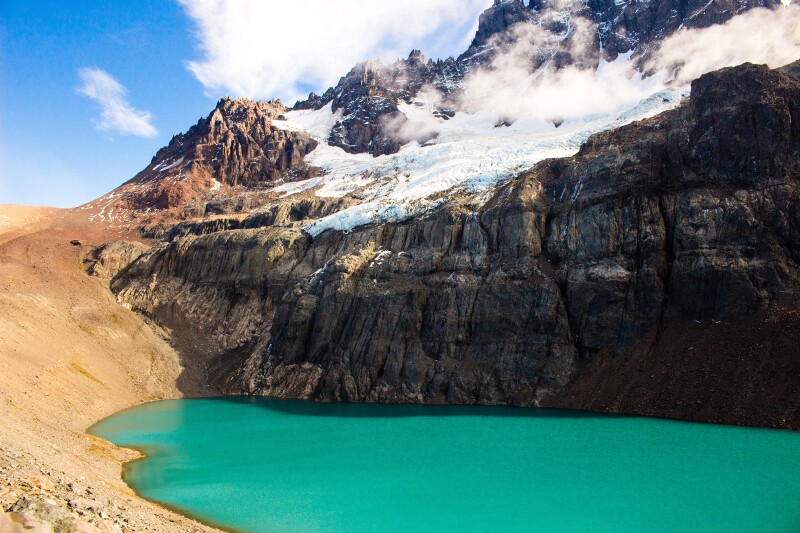Until recently, Torres del Paine National Park claimed all the glory when it came to the most scenic place in Chilean Patagonia. But with the opening of Chile’s La Ruta de los Parques (Route of Parks) in late 2018, and the recent unveiling of its info-packed website, 16 other national parks can now jockey for the attention of the hordes of travelers seeking untapped beauty in this rugged region.
The route stretches 1,700 miles from the Lakes District city of Puerto Montt in the north, along the Aysen region’s Carretera Austral highway, and through the Magallanes region (home of Torres del Paine) before ending at Cape Horn National Park. Its network of paved and gravel roads, trails, and ferry crossings offers myriad opportunities for exploration, including road-tripping, through-hiking, and cycling. Some parks are open year-round and others only from October to April (spring through fall in this hemisphere). Summer (November to February) remains the most popular time to visit, although fall and spring have their own benefits, such as fewer crowds and seasonal colors.

La Ruta de los Parques
Courtesy of Tompkins Conservation
Locals estimate that most travelers would need about six months to “do” the entire trail properly, but some sections, like the Carretera Austral, can be explored in one or two weeks. Where to start? The following parks, perfect for any kind of traveler, showcase Patagonia’s greatest hits and can’t-miss landscapes.
Alerce Andino National Park
The northernmost park on La Ruta, this 97,000-acre landscape of verdant forests, mountains, and more than 50 lakes (such as the serene Laguna Sargazo) is a great day-trip destination from Puerto Montt. Visitors can hike, kayak, canoe, and watch for wildlife like the pudú, the world’s tiniest deer. But Alerce Andino’s main draw is its mighty alerce trees, relatives of the redwood. Admire 3,000-year-old specimens of these endangered conifers on the Alerce Milenario trail.
While most visitors opt to drive an hour back to Puerto Montt for nights, it’s well worth heading two hours north to the picturesque Reloncavi estuary to overnight in the charming, rustic cabins at Ralun Patagonia.

Expect dramatic vistas like the Queulat glacier and its twin waterfalls at Queulat National Park at every park along the route.
Courtesy of Shutterstock
Queulat National Park
First introduced to Europeans in 1766 by a Jesuit priest searching for the City of the Caesars, a mystical city of riches believed to be located somewhere in Patagonia, Queulat’s treasures easily surpass gold: It’s home to misty temperate rain forests, glacier-fed lakes and rivers, and waterfalls cascading down sheer rock walls (queulat means “the sound of waterfalls” in the language of the Chonos people, for whom the area was ancestral lands).
Queulat’s top sites can all be reached by easy to intermediate day hikes, such as the Laguna Los Tempanos trail, which takes you over a hanging bridge to the Los Témpanos lagoon, open for boating and kayaking in the summer. But the park’s stand-out feature is the Queulat hanging glacier and its twin waterfalls, a spectacle best admired from a lookout at the end of a two-hour round-trip hike.
It’s possible to camp here, but you can also head across Dorita Bay to spring for a stay at Puyuhuapi Lodge. Built in the wood-tiled style of the nearby Chiloé islands, the lodge offers tranquil lake views, a gourmet restaurant, and natural outdoor hot springs.
Cerro Castillo National Park
Forty miles from Aysen’s regional capital of Coyhaique, Cerro Castillo offers one of Chile’s most spectacular multi-day treks, which culminates in a staggering view of the park’s eponymous massif of snow, ice, and rock, with the electric-turquoise Laguna Castillo at its base.

Find the arresting Laguna Castillo in Cerro Castillo National Park.
Courtesy of Shutterstock
While some choose to take on the four- to five-day trek, others access the famous viewpoint on a six-hour round-trip that ascends through native forests. Keep an eye out for Andean condors and elusive huemul deer. A deeply entrenched gaucho culture means it’s also possible to explore parts of the park on horseback, and rock climbers are increasingly drawn to the abundant and little-known ascents.
If you’re not tackling the backcountry trek, return to Coyhaique to crash at the equestrian-themed Nomades Boutique Hotel or the Coyhaique River Lodge, which is popular with fly fishermen.
Patagonia National Park
First purchased in 2004 by Douglas and Kris Tompkins and then combined with the preexisting Jeinimeni and Tamango National Reserves as part of the historic million-acre Tompkins land donation in 2019, this 752,503-acre poster child for Patagonian conservation is a natural masterpiece filled with steppe grasslands, southern beech tree forests, river confluences whose whorling colors put Van Gogh to shame, jewel-toned lakes, and stark mountains. The heart of the park, the Chacabuco Valley, was previously used as grazing land but now, successfully rehabilitated, is once again home to wildlife like spindly-legged guanacos and pumas.
Patagonia National Park is also one of the best-developed parts of La Ruta, with campsites, bathrooms, and an information center. Visitors like to mountain bike, boat, fly-fish, and stargaze, and the park has 20 trails to choose from, including the Mirador Lago Jeinimeni trail, which overlooks the vibrant Jeinimeni Lake.
Inspired by the grand hotels of U.S. national parks, the park’s Lodge at Valle Chacabuco offers sumptuous digs. For something more contemporary, try the modernist cabins at BordeBaker Lodge in nearby Cochrane.

Eerie and wonderful, the Marble Caves of Laguna San Rafael National Park are worth the effort.
Photo by Milosz Maslanka/Shutterstock
Laguna San Rafael National Park
Chile’s third-largest park encompasses an entire icefield (the 1,600-square-mile Northern Patagonian Icefield), as well as one of Patagonia’s most actively-calving but lesser-known glaciers. Reach the 230-foot-tall San Rafael glacier by boat or kayak via the park’s warren of iceberg-dotted fjords and channels. Visitors also come to ride horses in the forested valley of Los Leones or ice-hike the Exploradores glacier near Monte San Valentine, Patagonia’s highest peak. And don’t forget to stop by General Carrera Lake, home of the Marble Caves, famous for their hollowed-out caverns of multi-colored, marbled rock.
There are no lodgings inside the park, so try the neighboring Mallin Colorado EcoLodge with its tasteful, native-wood cabins and local handicrafts.
Kawesqar National Park
Although not the final park on La Ruta, Kawesqar is the best option to explore this part of the network; some of the southernmost parks are still not open to the public or are logistical nightmares to reach. Named after the local Kawesqar tribe, this national park covers an astonishing 7 million acres of fjords, islands, glacier-riddled cordilleras, Magellanic subpolar forests, and coastal archipelagos. (And it’s not even the largest park on the route! It’s dwarfed by the 8-million-acre Bernardo O’Higgins National Park.)
Rugged and remote, the primarily boat-accessible park is virgin territory, with no official trails or accommodations. Exploring calls for an expert guide, which you can find through the Patagonian Fjords boating expedition company. Aboard its nicely outfitted Exploradora boat, guests embark on boating and hiking trips, visiting places few other humans have ever set eyes on. Day-trippers from Puerto Natales (the gateway town to Torres del Paine) and Punta Arenas can also access sections of the park, like the southerly Isla Riesco near Francisco Coloane Marine Park, where they often spot migrating humpback whales and penguins.
>>Next: Egypt Opens 105-Mile Hiking Trail in the Red Sea Mountains











